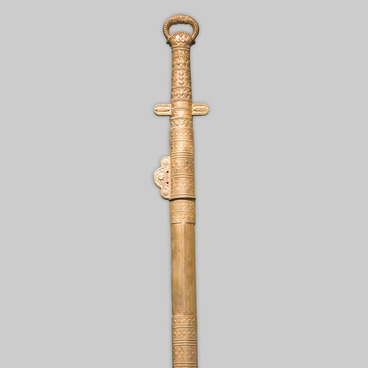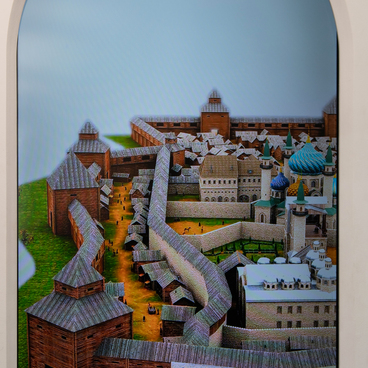In 1994–1995, during archaeological work in the central part of the Kremlin, employees discovered several stone weights. They were in one of the excavations in a layer that dates back to the time of the Kazan Khanate. One of them looked like a machined and polished disk with a small recess on both sides. On one side was a trident sign. Each stone weighed about 10 kilograms. The trident on the weight is the tamga of the Crimean Giray khans, who ruled the Kazan Khanate in the 16th century.
Tamga is a generic sign of property among nomadic peoples, with the help of which it is noted who owned the cattle. According to one version, totem animals were the prototypes of many signs. Geometric figures, sacred pictograms, birds and animals, household items, tools, weapons and horse harness were depicted on weights, sometimes — letters of different alphabets. As a rule, the descendant borrowed the tamga from his ancestor — father or grandfather — and added an additional element to it, or modified it. Later tamga began to be used as an emblem or a genus seal. For example, the Jochids had a ‘stirrup’, the Girays had a ‘trident’, and Tamerlane have three circles in the form of a rosette.
There are several assumptions about what the Giray’s tamga meant. Some researchers believe that the sign originated from the personal seals of the rulers of the ancient Bosporus kingdom. Their symbols consisted of several elements: a trident, a delta sign with “wings” on top, and a triangle or rhombus. The trident in the signs of the Bosporus kings symbolized their origin from Hercules, the son of the ancient Greek god Zeus.
The official image of the Giray’s tamga appeared at the end of the 15th century during the reign of khan Mengli-Giray. At that time, coins of the Crimean Khanate with a trident in the middle were in use. The same sign was present on the square seals of the khans, with which the documents were certified.
The weight that was found on the territory of the Kazan Kremlin with the tamga of the Crimean khans is evidence of close trade, economic, political and dynastic ties between Kazan and Crimea, as well as a sign that the Kazan Khanate participated in international relations with the largest states of its time.
Tamga is a generic sign of property among nomadic peoples, with the help of which it is noted who owned the cattle. According to one version, totem animals were the prototypes of many signs. Geometric figures, sacred pictograms, birds and animals, household items, tools, weapons and horse harness were depicted on weights, sometimes — letters of different alphabets. As a rule, the descendant borrowed the tamga from his ancestor — father or grandfather — and added an additional element to it, or modified it. Later tamga began to be used as an emblem or a genus seal. For example, the Jochids had a ‘stirrup’, the Girays had a ‘trident’, and Tamerlane have three circles in the form of a rosette.
There are several assumptions about what the Giray’s tamga meant. Some researchers believe that the sign originated from the personal seals of the rulers of the ancient Bosporus kingdom. Their symbols consisted of several elements: a trident, a delta sign with “wings” on top, and a triangle or rhombus. The trident in the signs of the Bosporus kings symbolized their origin from Hercules, the son of the ancient Greek god Zeus.
The official image of the Giray’s tamga appeared at the end of the 15th century during the reign of khan Mengli-Giray. At that time, coins of the Crimean Khanate with a trident in the middle were in use. The same sign was present on the square seals of the khans, with which the documents were certified.
The weight that was found on the territory of the Kazan Kremlin with the tamga of the Crimean khans is evidence of close trade, economic, political and dynastic ties between Kazan and Crimea, as well as a sign that the Kazan Khanate participated in international relations with the largest states of its time.



